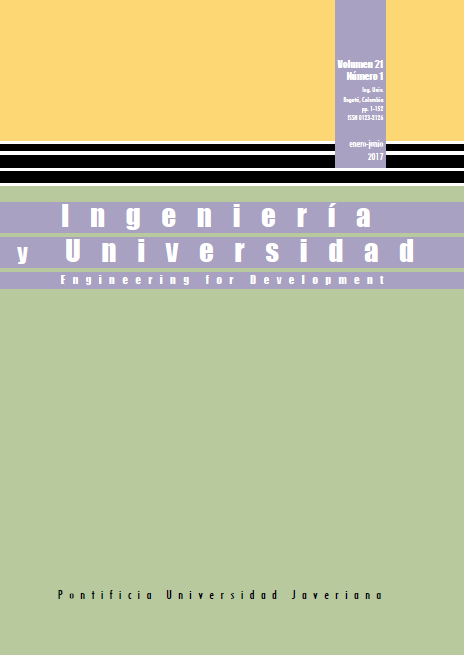Resumen
Introduction: This paper presents a monitoring and control system prototype using the internet protocol (IP) for a residential lighting layout. The prototype aims to develop energy efficiency processes by reducing electric energy consumption without decreasing user comfort and quality of life. Methods: The system is based on a web application to remotely turn the power on and off, which enables the monitoring of its consumption while being grounded in a prospective analysis. The prototype has hardware and software components. Results: The prototype has hardware is implemented with the Arduino® platform, which enables the assignment of an IP address using an Ethernet Shield card. This address provides bidirectional communication possibilities. The device is connected by a data acquisition system, which is designed and constructed to measure energy consumption from voltage and current measurements using an ADE7763® integrated circuit and an ACS714® current sensor. In this physical structure, a web application has been developed to monitor consumption and develop a control process with communication protocols through power line communication (PLC). Conclusions: The main contributions of this investigation are grounded in the use of economics and small devices that will enable low-cost energy-efficient project development in both domestic and industrial electric installations.
[2] Agencia Chilena de Eficiencia Energética, “Agencia Chilena de Eficiencia Energética,” 2013. [On line]. Available: http://www.acee.cl/eficiencia-energetica/ee.
[3] Unidad de Planeación Minero Energética (UPME), Consorcio Bariloche–BRP, “Consultoría para la formulación estratégica del plan de uso racional de energía y de fuentes no convencionales de energía 2007-2025,” Bogotá, 2007.
[4] Z. Corez, Restricciones de oferta, como problema hacia el desarrollo de una iluminación eficiente, Montevideo: Dirección Nacional de Energía, 2014.
[5] J. López, J. C. Arias, and E. Quintero, “Medidor electrónico interactivo de consumo de energía electríca para uso residencial,” Prospectiva, vol. 14, no. 1, p. 12, 2016.
[6] A. Faruqui, S. Sergici, and A. Sharif, “The impact of informational feedback on energy consumption – a survey of the experimental evidence,” Energy, vol. 35, p. 1598–1608, 2010.
[7] J. Á. Noguera, Sistema de diálogo basado en mensajería instantánea para el control de dispositivos en el internet de las cosas, Murcia: Universidad de Murcia, 2016.
[8] J. N. Louis, A. Caló, K. Leiviskä, and E. Pongrácz, “Modelling home electricity management for sustainability: The impact of response levels, technological deployment & occupancy,” Energ Buildings, pp. 218-232, 2016.
[9] B. E. Priya and K. K. Sathish, “A survey on residential demand side management architecture, approaches, optimization models and methods,” Renew Sust Energ Rev, vol. 59, pp. 342–351, 2016.
[10] Green Wave Reality, “Smart Home,” 5 September 2016. [on line]. Available: https://greenwavesystems.com/solutions/home-automation/.
[11] OZOM, “Controla tu hogar a distancia,” [on line]. Available: http://www.ozom.com.
[12] A. Ibáñez, Las nuevas bombillas con dirección IP. [Interview]. May 18, 2011.
[13] D. Talbot, “Cuando internet descubrió la bombilla,” MIT Technology Review, May 22, 2014.
[14] J. L. Soler Llorens, J. J. Galiana Merino, J. Giner Caturla, P. Jauregui Eslava, S. Rosa Cintas y P. Rosa Herranz, “Development and programming of Geophonino: A low cost Arduino-based seismic recorder for vertical geophones,” Comput Geosci, vol. 94, p. 1–10, 2016.
[15] Serial peripheral interface and related methods, by S. Pezzini, Estados Unidos Patent US7069352 B2, 2006.
[16] Arduino, “Arduino,” 2016. [on line]. Available: https://www.arduino.cc/en/pmwiki.php?n=Main/ArduinoEthernetShield.
[17] Microchip, “Microchip,” February 1, 2016. [on line]. Available: http://ww1.microchip.com/downloads/en/DeviceDoc/39662c.pdf.
[18] Microchip, “Microchip,” 12 July 2016. [On line]. Available: http://www.microchip.com/wwwproducts/Devices.aspx?dDocName=en022889. [Last access: 20 July 2016].
[19] Analog Devices, “Analog Devices,” 2016. [On line]. Available: http://www.analog.com/en/products/analog-to-digital-converters/integrated-special-purposeconverters/energy-metering-ics.html.
[20] M. Meneghini, A. Cester, G. Mura, E. Zanoni y G. Meneghesso, “Influence of shunt resistance on the performance of an illuminated string of solar cells: theory, simulation, and experimental analysis,” IEEE T. Device Mat. Re., vol. 14, no. 4,p. 8, 2014.
[21] F. Enríquez, E. Sifuentes de la Hoya, J. d. D. Cota, L. Rascón, J. Estrada y F. López, “Sistema de monitoreo de variables eléctricas V, I y P,” Cultura Científica y Tecnología, vol. 57, no. 12, p. 9, Septiembre 2015.
[22] G. D. Donato, M. Pulvirenti, F. G. Capponi y G. Scarcella, “Hall-effect sensor fault detection, identification, and compensation in brushless DC Drives,” IEEE T. Ind. Appl., vol. 52, no. 2, pp. 1542-1554, 2016.
[23] Sigma Electrónica, “Sigma electrónica,” 2016. [On line]. Available: http://www.sigmaelectronica.net/ade7763arsz-p-1732.html. [Last access: 4 March 2016].
[24] ISA, “Ingeniería de sistemas y automática,” 2016. [on line]. Available: http://isa.uniovi.es/docencia/AutomEdificios/transparencias/actuadores.pdf.
[25] G. G. A. Juan Carlos Vesga, “Statistical model on throughput behavior of LAN networks over power line communications technology,” Ing. Univ., vol. 16, no. 2, p. 433, 2012.
[26] Tp-Link, “Adaptador Nano Powerline AV500,” May 23, 2016. [On line]. Available: http://www.tp-link.com/co/products/details/TL-PA4010KIT.html.
[27] S. Baldi, I. Michailidis, C. Ravanis and E. B. Kosmatopoulos, “Model-based and model-free ‘‘plug-and-play’’ building energy efficient control,” Appl. Energ, vol. 154, pp. 829–841, 2015.
[28] Analog Devices, “Datasheet ADE 7763,” Norwood, 2016.
[29] Universidad Politécnica de Querétaro, Manual para determinar la dirección MAC, México, 2016.
[30] datasheetcatalog, “Data Sheet Catalog,” January 20, 2016. [On line]. Available: http://pdf.datasheetcatalog.com/datasheet/SGSThomsonMicroelectronics/mXyzzyw.pdf.
[31] HTinstruments, “HTinstruments,” Jan 20, 2016. [On line]. Available: http://www.htinstruments.es/analizador-de-redes-profesionales-para-la-medida-registrode-los-parametros-de-red-segun-la-en50160.
Una vez aceptado un trabajo para publicación la revista podrá disponer de él en toda su extensión, tanto directamente como a través de intermediarios, ya sea de forma impresa o electrónica, para su publicación ya sea en medio impreso o en medio electrónico, en formatos electrónicos de almacenamiento, en sitios de la Internet propios o de cualquier otro editor. Este uso tiene como fin divulgar el trabajo en la comunidad científica y académica nacional e internacional y no persigue fines de lucro. Para ello el autor o los autores le otorgan el permiso correspondiente a la revista para dicha divulgación mediante autorización escrita.
Todos los articulos aceptados para publicación son sometidos a corrección de estilo. Por tanto el autor /los autores autorizan desde ya los cambios sufridos por el artículo en la corrección de estilo.
El autor o los autores conservarán los derechos morales y patrimoniales del artículo.


